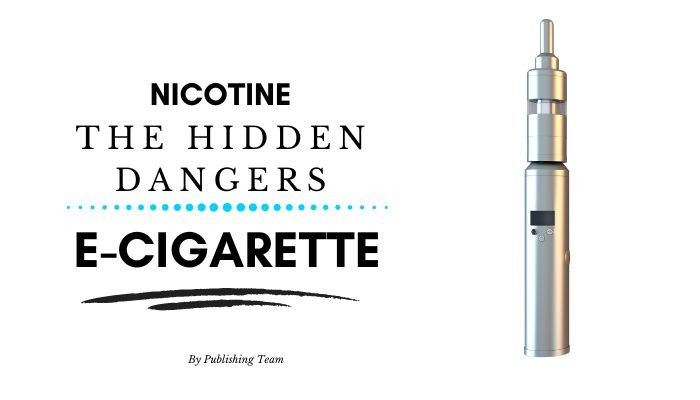Nicotine: The Hidden Dangers in Your E-Cigarette
By Publishing Team

Smoking has long been known to be a dangerous habit, leading to a host of health problems ranging from lung cancer to heart disease. However, with the rise of e-cigarettes, many people believe they have found a safer alternative to traditional smoking. Unfortunately, this is far from the truth. E-cigarettes, or vapes, still contain nicotine, a highly addictive and toxic substance that can have serious consequences for your health.
What is Nicotine?
Nicotine, once only a naturally occurring alkaloid found in the nightshade family of plants, including tobacco, now can be made synthetically. Nicotine acts as a stimulant, producing feelings of euphoria and relaxation. However, it also has addictive properties, which is why smokers find it so difficult to quit.
The Dangers of Nicotine
Addiction
Nicotine is highly addictive, which is why people who start using e-cigarettes or traditional cigarettes often find it difficult to quit. This can lead to a lifetime of addiction and an increased risk of health problems. I’ve talked to so many people who say the “just enjoy” *insert current nicotine product here*. That enjoyment is what keeps them coming back, and that is called addiction.

Heart Disease
Nicotine has been shown to increase the risk of heart disease, including heart attack and stroke. This is because it causes the blood vessels to narrow, increasing blood pressure and putting stress on the heart. It also increases the risk of blood clots, which can lead to heart attack and stroke.
Lung Damage
Nicotine can cause lung damage, particularly in people who use e-cigarettes. This is because the vapor produced by e-cigarettes contains chemicals and particles that can irritate the lungs, leading to respiratory problems such as cough, wheezing, and shortness of breath.
Brain Development
Nicotine can have a negative impact on brain development, particularly in young people. This is because the brain continues to develop until the age of 25, and exposure to nicotine during this time can disrupt the development of the brain, leading to problems with attention, memory, and behavior.
Pregnancy
Nicotine is also dangerous for pregnant women and their developing fetus. It has been shown to increase the risk of low birth weight, premature birth, and stillbirth. It can also lead to problems with brain development and behavioral problems in the child.
Secondhand Smoke
In addition to the dangers to the smoker, nicotine can also harm those nearby through secondhand smoke. This is because the smoke produced by e-cigarettes and traditional cigarettes contains chemicals and particles that can be harmful to those inhaling them. Most states in the U.S. now prohibit the use of any vaping device or cigarettes inside buildings because of secondhand smoke.

Withdrawal Symptoms
Finally, nicotine withdrawal can be a difficult process for those trying to quit smoking. Symptoms of nicotine withdrawal can include irritability, anxiety, depression, difficulty concentrating, and insomnia. This is why FlowBlend was created, to squash withdrawal symptoms and increase your chance of quitting successfully.

Conclusion
The dangers of nicotine are clear and cannot be ignored. Whether you are using e-cigarettes or traditional cigarettes, nicotine is a toxic and addictive substance that can have serious consequences for your health. If you are a smoker, quitting is the best thing you can do for your health, and FlowBlend is available to help you, be sure to check out the reviews to hear about all the other successful people who have quit. If you want to protect your health and the health of those around you, it is time to put down the e-cigarette and quit smoking for good.
Here are some additional tips for breaking the habit of nicotine addiction:
Seek Support
Quitting nicotine can be a difficult and challenging process, but you don't have to do it alone. Seek support from family and friends, or consider joining a support group, such as Nicotine Anonymous. Talking to others who have gone through the process of quitting can provide you with the encouragement and motivation you need to stay on track.
Set a Quit Date
Setting a quit date can help you stay focused and give you a goal to work towards. Choose a date that is reasonable, but not too far in the future, and make a plan for how you will manage the withdrawal symptoms.
Find Alternatives
One of the reasons that nicotine is so addictive is that it helps people cope with stress and anxiety. To help break the cycle of addiction, it's important to find alternative ways to cope with these feelings. This might include exercise, deep breathing, meditation, and definitely FlowBlend.
Use Nicotine Replacement Therapy
Nicotine replacement therapy (NRT) is a form of medication that can help people quit smoking. NRT works by gradually reducing the amount of nicotine in the body, reducing withdrawal symptoms and cravings. There are several forms of NRT available, including nicotine gum, patches, lozenges, and inhalers. The biggest problem with these items is your just trading one addiction for another. I know many that have used Nicotine gum for years.
Find a Cope for Triggers
Triggers are things that make you want to smoke or use an e-cigarette. Common triggers include stress, caffeine, alcohol, and social situations. Identifying your triggers and having a plan ready for what you can do instead can help you stay on track and avoid slipping back into nicotine addiction. Come up with one or two things you can do when a craving is triggered, like chewing gum or using a FlowBlend pouch.
Get Active
Physical activity is a great way to reduce stress and anxiety, and it can also help you quit smoking. Regular exercise can help you manage withdrawal symptoms, reduce cravings, and improve your overall mood.
Reward Yourself
Quitting nicotine is a big accomplishment, and it's important to reward yourself for your hard work. Set small goals for yourself along the way and reward yourself with something you enjoy, such as a movie or a special treat.
Quitting nicotine can be a difficult process, but with the right tools and support, it is possible. Remember to seek support, set a quit date, find alternatives, use nicotine replacement therapy, avoid triggers, get active, and reward yourself. Breaking the cycle of nicotine addiction takes time and effort, but the benefits to your health and wellbeing are worth it.








